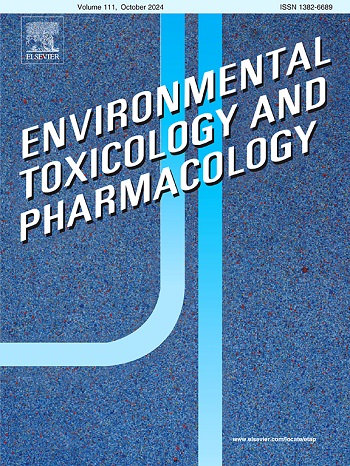利用h2o2诱导的mellonella幼虫的敏感性:一个探索氧化应激和生物标志物的强大模型。
IF 4.2
3区 环境科学与生态学
Q2 ENVIRONMENTAL SCIENCES
引用次数: 0
摘要
氧化应激在各种病理条件下起着至关重要的作用。本研究介绍了过氧化氢(H2O2)诱导的mellonella幼虫应激增强模型,为氧化应激研究提供了一种经济有效且合乎伦理的替代方法。该模型连接了体外和体内研究,以鉴定生物标志物,如脂质过氧化,蛋白质羰基化,血细胞计数和抗氧化酶活性。结果表明,尽管大黄蜂幼虫对高剂量H2O2具有耐受性,但随着中毒时间的延长和H2O2浓度的升高,大黄蜂幼虫对H2O2的敏感性增加。急性H2O2暴露(5.0M/第1天)导致脂肪和蛋白质氧化升高,超氧化物歧化酶活性和血细胞计数下降,过氧化氢酶活性和总抗氧化能力增加。尽管有这些防御措施,但在严重的氧化应激下,幼虫的抗氧化能力不足,从而降低了存活率。本研究强调,mellonella幼虫是检测活性氧(ROS)诱导的氧化应激的有希望的模型。本文章由计算机程序翻译,如有差异,请以英文原文为准。
Harnessing H2O2-induced susceptibility in Galleria mellonella larvae: A robust model for exploring oxidative stress and biomarkers
Oxidative stress plays a crucial role in various pathological conditions. This study introduces an enhanced model using hydrogen peroxide (H2O2)-induced stress in Galleria mellonella larvae, offering a cost-effective and ethically sound alternative for oxidative stress research. The model bridges in vitro and in vivo studies to identify biomarkers like lipid peroxidation, protein carbonylation, hemocyte count, and antioxidant enzyme activities. Our results show that while G. mellonella larvae tolerated high doses of H2O2, increased susceptibility occurred with prolonged toxicosis and higher concentrations. Acute H2O2 exposure (5.0 M/1st day) led to elevated lipid and protein oxidation and decreased superoxide dismutase activity and hemocyte count, while catalase activity and total antioxidant capacity increased. Despite these defenses, the larvae's antioxidant capacity was insufficient under severe oxidative stress, reducing survival. This study highlights G. mellonella larvae as a promising model for examining reactive oxygen species (ROS)-induced oxidative stress.
求助全文
通过发布文献求助,成功后即可免费获取论文全文。
去求助
来源期刊
CiteScore
7.00
自引率
4.70%
发文量
185
审稿时长
34 days
期刊介绍:
Environmental Toxicology and Pharmacology publishes the results of studies concerning toxic and pharmacological effects of (human and veterinary) drugs and of environmental contaminants in animals and man.
Areas of special interest are: molecular mechanisms of toxicity, biotransformation and toxicokinetics (including toxicokinetic modelling), molecular, biochemical and physiological mechanisms explaining differences in sensitivity between species and individuals, the characterisation of pathophysiological models and mechanisms involved in the development of effects and the identification of biological markers that can be used to study exposure and effects in man and animals.
In addition to full length papers, short communications, full-length reviews and mini-reviews, Environmental Toxicology and Pharmacology will publish in depth assessments of special problem areas. The latter publications may exceed the length of a full length paper three to fourfold. A basic requirement is that the assessments are made under the auspices of international groups of leading experts in the fields concerned. The information examined may either consist of data that were already published, or of new data that were obtained within the framework of collaborative research programmes. Provision is also made for the acceptance of minireviews on (classes of) compounds, toxicities or mechanisms, debating recent advances in rapidly developing fields that fall within the scope of the journal.

 求助内容:
求助内容: 应助结果提醒方式:
应助结果提醒方式:


